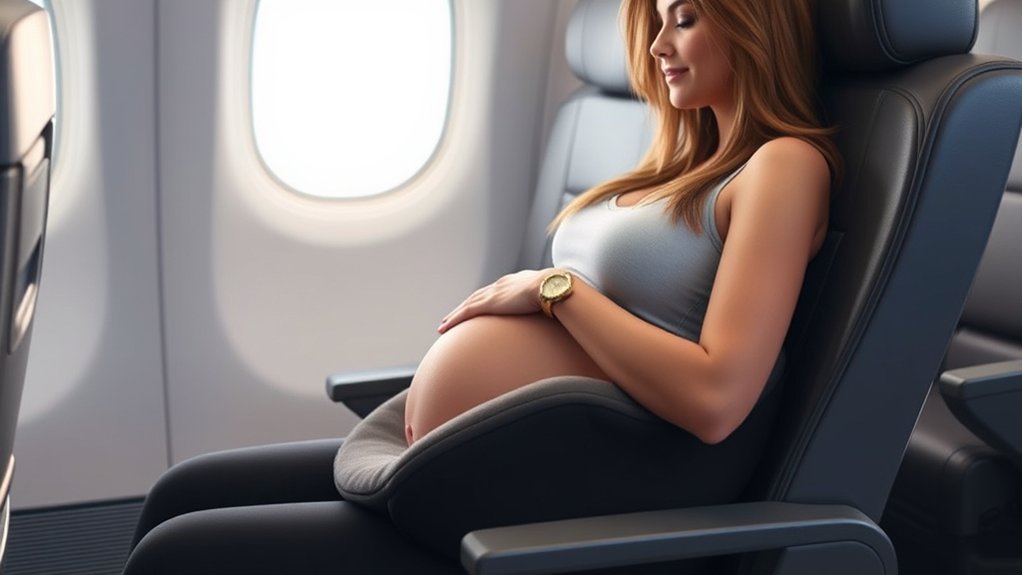Many airlines have specific rules regarding car seats that you might not be aware of, which can make traveling during pregnancy feel even more challenging. Finding the right car seat and ensuring it meets airline regulations is essential for both your comfort and your baby’s safety. As you prepare for your journey, consider how to make this experience smoother and more enjoyable. What options do you have for managing comfort while steering through these policies?
Understanding Airline Policies on Car Seats
When you travel while pregnant, understanding airline policies on car seats is crucial for a smooth journey. Each airline has specific guidelines regarding the use of car seats on flights, so it’s important to check these before you fly.
Some airlines allow car seats for infants under two years, while others may have restrictions. Make sure the car seat meets FAA regulations and is properly labeled.
You’ll also want to confirm if you can use it in a window seat, as that’s often a requirement. Having this information in advance can reduce stress and guarantee your little one’s safety.
Choosing the Right Car Seat for Air Travel
Choosing the right car seat for air travel can feel overwhelming, especially with all the options available.
Selecting the ideal car seat for air travel can be daunting with so many choices at hand.
You’ll want a seat that’s lightweight and easy to install on the plane. Look for FAA-approved models, as these are designed for safety and compatibility with airline regulations.
Consider your child’s age and size; a rear-facing seat is best for infants, while a convertible seat can grow with your child.
Don’t forget about comfort—choose a seat with ample padding and support. If you’re traveling frequently, investing in a travel-specific car seat could save you time and hassle.
Tips for Installing a Car Seat on a Plane
Installing a car seat on a plane may seem intimidating, but with the right approach, it can be a smooth process. First, check your airline’s policies regarding car seats to guarantee compliance.
When you arrive at the gate, ask for assistance from the staff—they’re usually happy to help. Before boarding, familiarize yourself with the car seat’s installation instructions.
Once seated, position the car seat in the window seat, as this is often required for safety. Secure it tightly using the airplane seatbelt, ensuring there’s no movement. Don’t hesitate to adjust the seat if needed; a snug fit is key.
Finally, practice patience and stay calm—everyone around you understands the challenges of traveling with little ones.
Comfort and Safety Considerations for Expectant Mothers
Although flying during pregnancy can be challenging, prioritizing your comfort and safety is essential.
When booking your flight, consider choosing an aisle seat for easier access to the restroom and the ability to stretch your legs. Wear loose, breathable clothing and supportive shoes to enhance your comfort.
Stay hydrated by drinking plenty of water, and don’t hesitate to ask the flight attendants for assistance if needed. You should also walk around the cabin periodically to improve circulation and reduce the risk of swelling.
If you experience any discomfort, let your healthcare provider know before your trip.
Alternatives to Using a Car Seat During Air Travel
When traveling by air with a young child, there are several alternatives to using a car seat that can make your journey easier and more comfortable.
Instead of a traditional car seat, consider using a travel harness designed for airplanes, which is lightweight and easy to use. You might also opt for a child safety vest, providing security without the bulk of a car seat.
If your child is old enough, using an FAA-approved booster seat can offer safety while being more portable. Many airlines also provide child-friendly seat belts.
Always check your airline’s policies to see what accommodations they offer. Whichever option you choose, prioritize your child’s safety and comfort to create a smoother travel experience.
Frequently Asked Questions
Can I Use My Car Seat for Other Children on the Plane?
You can’t use your car seat for other children on the plane. Each child needs their own approved seat. It’s best to check with your airline for specific policies regarding child safety seats.
What Should I Do if My Car Seat Is Damaged During Travel?
If your car seat’s damaged during travel, report it immediately to the airline. Studies show nearly 25% of passengers experience luggage issues. They often offer compensation or a replacement, so don’t hesitate to advocate for yourself.
Are There Weight Limits for Car Seats on Airplanes?
Yes, most airlines have weight limits for car seats, typically around 40 pounds. Always check your airline’s specific guidelines before traveling to guarantee your car seat meets their requirements and keeps your child safe.
How Do I Know if My Car Seat Meets Airline Regulations?
Check your car seat’s label for FAA approval; it’ll show if it meets airline regulations. If you’re unsure, consult the airline directly. After all, peace of mind is essential when traveling with little ones!
Can I Bring a Stroller Along With the Car Seat on the Plane?
Yes, you can usually bring a stroller along with your car seat on the plane. Just check your airline’s specific policies, as they may have size or weight restrictions. You’ll want everything to be hassle-free.
Conclusion
So, as you navigate the skies with your little co-pilot, remember that a car seat isn’t just a fancy accessory—it’s your ticket to a safer flight. Sure, you could let your toddler bounce around the cabin like a pinball, but why not avoid that delightful chaos? Prioritize comfort, stay hydrated, and consult your doc. After all, you’re not just flying; you’re commencing an adventure that requires a little planning and a lot of humor. Safe travels!
